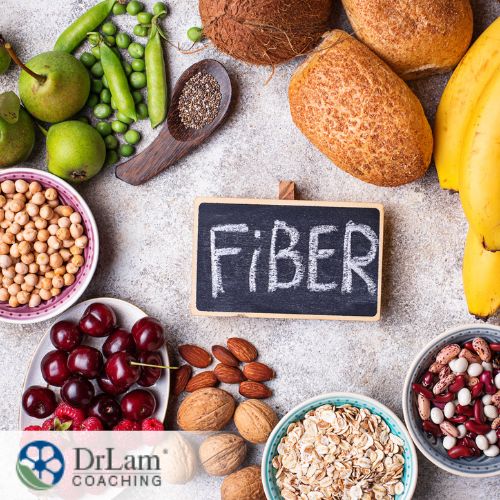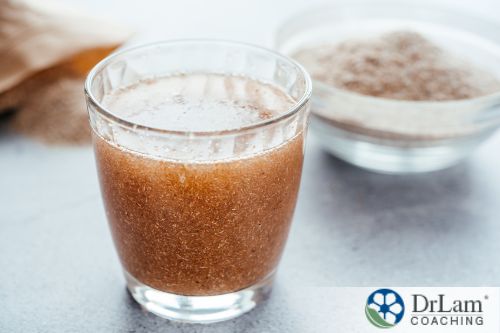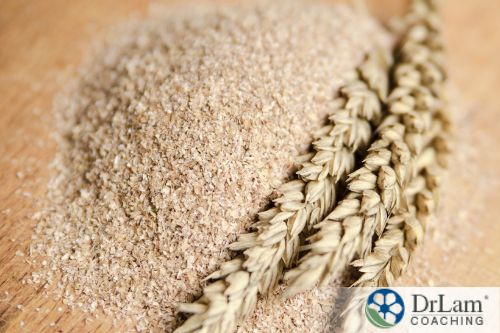 A few years ago, you probably used to hear a lot about how you should increase fiber in your diet. But then, as new dietary trends began emerging, this topic began fading into the background. But that’s quite unfortunate, as fiber is still one of the most important components of a healthy diet. It’s also one of the main reasons plant foods are so beneficial. Especially when it comes to your gastrointestinal (GI) tract and your gut microbiome.
A few years ago, you probably used to hear a lot about how you should increase fiber in your diet. But then, as new dietary trends began emerging, this topic began fading into the background. But that’s quite unfortunate, as fiber is still one of the most important components of a healthy diet. It’s also one of the main reasons plant foods are so beneficial. Especially when it comes to your gastrointestinal (GI) tract and your gut microbiome.
When your GI tract is working well and your microbiome is balanced, you feel good. You digest your food well, you have very mild food sensitivities (if at all), you have regular bowel movements, and you have lots of energy. Good digestion also means you get the most nutritive value from the food you eat.
Truly, the gut and microbiome can be considered central to your overall wellbeing. Including your mental health and your immunity. This is so for two reasons.
Firstly, your gut contains two-thirds of your immune system cells in what’s called the Gut-Associated Lymphoid Tissue (GALT). That’s why inflammation almost always begins in the gut. It’s also because your gut is your biggest interface with the outside world, so your system comes into contact with pathogens and toxins often via your GI tract. And your immune system has to respond quickly when that happens.
Secondly, the bacteria in your gut produce many neurotransmitters and neurochemicals. In fact, they make around 95% of your serotonin supply. Your brain then uses these neurotransmitters to regulate both mental and physiological processes. This means that your gut influences how you think, feel, learn, remember, and behave.
That is why protecting the health of your GI tract is so important. And one of the best and most efficient ways to do that is to increase fiber.
Most people don’t get enough fiber. Compared to our ancestors, we’re barely coming close to half of the amount of fiber they consumed. This is strange, considering how easy and accessible it is to eat an array of fiber-rich foods. But the convenience of the Standard Western Diet, with its highly processed foods, refined carbohydrates, simple sugars, and saturated fat may be to blame. Most of us need to reeducate ourselves on how to eat better again.
A good target to aim for is 28-35 grams of fiber a day for women and men respectively. You’ll also need to get enough of the two types of fiber: soluble and insoluble. Even better is to get these two types of fibers from a variety of sources, as that will also help you get a variety of other important nutrients, such as vitamins, minerals, antioxidants, and phytonutrients.
 Soluble fiber is the type that dissolves in water, which makes it fermentable. Because it is fermentable by bacteria, its main benefit is that it feeds your gut’s “good” bacteria. When your microbiome has more beneficial bacteria, they keep the “bad” bacteria in check. That’s when your microbiome is in balance and can function well.
Soluble fiber is the type that dissolves in water, which makes it fermentable. Because it is fermentable by bacteria, its main benefit is that it feeds your gut’s “good” bacteria. When your microbiome has more beneficial bacteria, they keep the “bad” bacteria in check. That’s when your microbiome is in balance and can function well.
Soluble fiber also helps keep the release of glucose gradual when you’re digesting carbohydrates. This is great for your blood sugar stability, as you avoid getting a sudden blood sugar spike that then leads to a crash.
Soluble fiber also reduces the absorption of fat from food, which is good for weight loss, and it lowers cholesterol, which is good for cardiovascular health. And it may help decrease the risk of colorectal cancer, though that link needs more research to back it up.
Some examples of soluble fiber are beans, psyllium, peas, carrot, and flaxseeds.
Insoluble fiber is what cleans out your GI tract. It acts like a kind of brush that catches old and stale food that’s stuck to the lining of your intestines. Insoluble fiber holds onto water, but it doesn’t dissolve in it, which means it’s not fermentable. It helps your stools become softer and bulkier, which makes them move more easily through your system. That’s why it is also credited with improving gut motility, the wave-like movements of your enteric muscles, which can relieve constipation.
Examples of insoluble fiber are bran, whole grain, chickpeas, lentils, potato skins, and vegetables.
Dysbiosis is the imbalance of your gut microbiome. It’s when the harmful bacteria outnumber the beneficial ones. It has many implications for your health.
First of all, it messes up the production of neurotransmitters and can create problems with the GALT. But it also creates another problem that is especially hazardous to your health: it can be the root cause of chronic inflammation.
Inflammation is a natural and healthy part of your immune response. It attacks and gets rid of pathogens and harmful substances. But it’s supposed to subside as soon as the job is done in order to allow your system to go back to a state of resting and digesting. Chronic inflammation, on the other hand, contributes to the development of many chronic health issues, both physical and mental/emotional.
One of the most common ways people develop chronic inflammation is because of dysbiosis. Dysbiosis allows the tight junctions in your gut wall to loosen, creating leaks. These leaks then allow substances into your bloodstream that shouldn’t be there, things like pathogens, toxins, and food particles. Their presence triggers an immune response, which comes with inflammation. But because the leaks remain, more substances enter, and your immune system is triggered over and over again. This leads to chronic inflammation.
Interestingly, one way to test for dysbiosis is by checking your Short Chain Fatty Acids (SCFAs) levels. SCFAs are a type of fatty acid with less than six carbons, and they are the result of the fermentation of indigestible food by your gut bacteria. Remember how we said soluble fiber is fermentable? If your SCFA levels are low, it means you’re not getting enough fiber and you may have dysbiosis.
 Chronic inflammation that begins in the gut can easily travel to other areas of your body. If it reaches your skin, you may experience skin rashes. When it reaches the joints, it can cause joint pain and swelling. Chronic inflammation that reaches your brain can cause neurological and psychiatric symptoms. In fact, researchers are theorizing that some of the most common mental health issues, such as anxiety and depression, have chronic low-grade inflammation as one of the main contributing factors.
Chronic inflammation that begins in the gut can easily travel to other areas of your body. If it reaches your skin, you may experience skin rashes. When it reaches the joints, it can cause joint pain and swelling. Chronic inflammation that reaches your brain can cause neurological and psychiatric symptoms. In fact, researchers are theorizing that some of the most common mental health issues, such as anxiety and depression, have chronic low-grade inflammation as one of the main contributing factors.
We like to look at health holistically, and we take the whole-person approach to improving our clients’ health and wellbeing. That’s why we developed and use the NeuroEndoMetabolic (NEM) Stress Response model when working with people. It takes into account all the different organs and systems that work together to fight stress. And when we talk about stress, we mean any physical or psychological pressure that induces a stress response.
Your NEM is a network of six circuits, each with three main components and each with a specific domain of action when it comes to responding to stress. They are the Hormone, the Bioenergetics, the Neuroaffect, the Cardionomic, the Inflammation, and the Detoxification Circuit.
Your Inflammation circuit is made up of your immune system, GI tract, and microbiome. These components work together to create the inflammation that helps rid your body of harmful substances as well as any cells and tissues damaged by those substances. If this circuit gets dysregulated, that may lead to chronic inflammation, lowered immunity, problems with neurotransmitter production, and digestive issues. And Inflammation Circuit dysregulation, along with whatever has caused it, like dysbiosis, is a form of chronic stress.
Chronic stress can trigger Adrenal Fatigue Syndrome (AFS), where your adrenals have to overwork to produce cortisol, your body’s main anti-stress hormone. Symptoms of AFS include fatigue, weight gain, sleep disturbances, brain fog, anxiety, mild depression, fertility issues, blood sugar and blood pressure instability, frequent colds and flu, food and drug sensitivities, and heart palpitations, to name a few.
Fiber can help some of these symptoms as well. For example, by balancing your Inflammation Circuit, you may help resolve the brain fog, anxiety, and mild depression that are linked to it. It can also stabilize your blood sugar levels and help with weight loss as well.
Your Inflammation Circuit needs a well-functioning Detoxification circuit supporting it. Otherwise, if detoxification is sluggish, the toxins and metabolic byproducts in your system will accumulate, causing more inflammation.
Your Detoxification Circuit is made up of your liver, immune system, and interstitium. Your liver is your body’s most important detoxification organ. The interstitium is the extracellular matrix, the fluid between cells, where substances that need to be detoxified travel. And your immune system is what attacks and neutralizes the substances that will be later detoxed from your system. But apart from these main components, other organs and systems also play a role in detoxification, including your kidneys, lungs, and GI tract.
 As noted above, insoluble fiber can detoxify your GI tract by helping to sweep out any substances stuck to the walls of your intestines. And more importantly, the soluble fiber helps balance out your microbiome and improves the function of your GI tract, which can make a huge difference to your Inflammation Circuit. And we’ve seen just how important it is to have a healthy gut and microbiome when it comes to inflammation, otherwise the risk of chronic inflammation and its damaging effects increase.
As noted above, insoluble fiber can detoxify your GI tract by helping to sweep out any substances stuck to the walls of your intestines. And more importantly, the soluble fiber helps balance out your microbiome and improves the function of your GI tract, which can make a huge difference to your Inflammation Circuit. And we’ve seen just how important it is to have a healthy gut and microbiome when it comes to inflammation, otherwise the risk of chronic inflammation and its damaging effects increase.
We understand that, for some people, it can be quite uncomfortable to suddenly increase fiber. If that’s you, don’t worry. There are ways to increase fiber in your diet without having to worry about bloating, gas, cramping, and constipation. Just follow these five steps:
It’s also possible to use fiber supplements made with psyllium, inulin, and methylcellulose. However, we strongly advise you to increase fiber through food. But if there’s a strong reason to use supplements temporarily, make sure you do so under the supervision of a medical professional. This is especially important if you have AFS, as you can get paradoxical reactions, like constipation.
It’s important to increase fiber if your diet is lacking it. And most people today don’t get enough of it. Fiber helps balance your microbiome, clean out your gut, lower your cholesterol, stabilize your blood sugar levels, and reduce your weight. These are all great benefits, but even more so if you have AFS or Inflammation Circuit dysfunction. It is also helpful for detoxification, which is another great way to reduce chronic inflammation in your body.
Make sure you remember to get both types to reap their full health benefits. Soluble fiber feeds your good bacteria, and insoluble fiber moves food through your system more efficiently.
These kinds of dietary changes are the foundations of our NEM and AFS recovery programs. But they can be challenging and confusing to implement, especially if you’re new to this. If you’d like to learn more about our individualized approach and our focus on natural solutions, we’d be happy to talk to you during a free initial consultation.
If you increase fiber in your diet, you will improve your physical health and your mental clarity as well. Fiber does wonders for your gut and microbiome, which are central to mental wellbeing. Fiber also fights inflammation, especially the kind that spreads throughout your body, wreaking havoc along the way.
